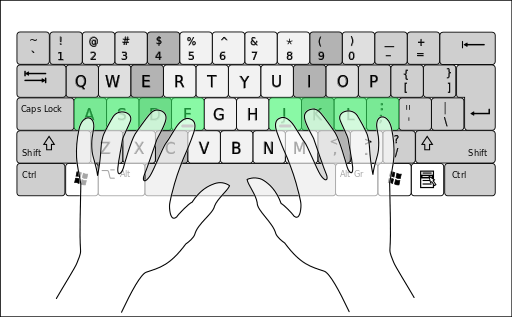Why Should Children Learn Touch-Typing

Cy21 [CC BY-SA 3.0], via Wikimedia Commons
Why children should learn touch-typing
With computers being integrated into classrooms across the country, typing is a fundamental skill required for effective interaction with the machines. Here are some reasons why every child should learn this skill:
- Touch-typing increases accuracy and speed which helps children to work faster.
- The quality of their work improves as all attention is focussed on content while muscle memory takes care of the typing.
- They become less prone to repetitive strain injury (RSI) than if they use “hunt and peck” to type.
- More and more teachers are allowing and expecting students to type up homework in middle and high schools.
- Sufficient time is not devoted to learning typing at school.
- It gives them an advantage over their peers and makes them more confident.
Resources to learn touch-typing
Learning to type involves mastering technique, accuracy and speed. Technique comprises of properly positioning the fingers on the keyboard, wrists remaining flat, thumbs on the space bar and eyes on the monitor. There are many software programs and online websites that teach typing. My recommendation is to try Typing Club’s Typing Jungle program. It is free and has the right combination of drills, reviews and progress updates. The feature that stands out most to me in TypingClub is the judicious use of gamification.
Best age to start learning touch-typing
What is the best age to start learning keyboard is a much debated topic among educators. There are benefits to starting earlier, but around fifth or sixth grade children are more likely to put in the regular practice needed and be responsive to feedback from the software and teacher or parent.
How can parents help the child in learning touch-typing
Parents can help by making sure the child is sitting with a proper posture and the keyboard is at a height so that a penny balanced on the wrist doesn’t fall off. A daily practice of 15 minutes or two 10 minute sessions works best. With this amount of practice, it takes most children about 8-10 weeks to reach a speed of 30 wpm (words-per-minute) with 90 percent accuracy. The emphasis should always be more on accuracy and technique; speed will follow naturally as the fingers get trained.
Isn’t touch-typing is on its way out?
Like we still need candles thanks to PG&E power outages, typing will continue to remain a useful skill for quite a while as speech recognition technology takes time to evolve. Typing is easy to learn, a skill for life and gives children many advantages in school and beyond. With a little guidance and encouragement from parents and regular practice for 8-10 weeks, any child can master this skill which once mastered, lasts for a lifetime.
FUN TEST
What is your typing speed and accuracy? Take a test and find out.


